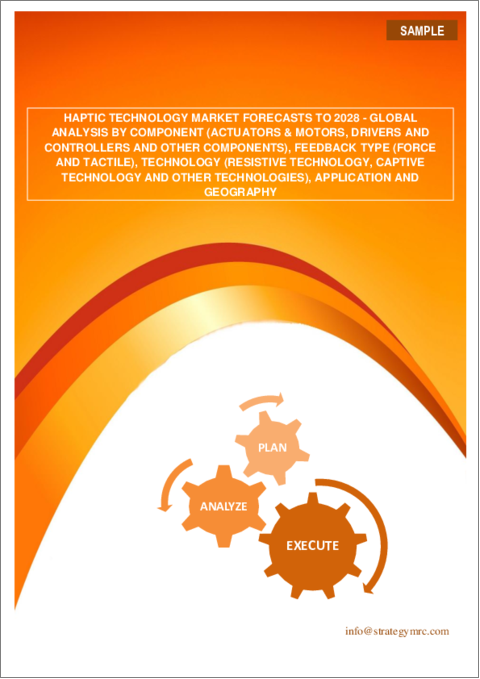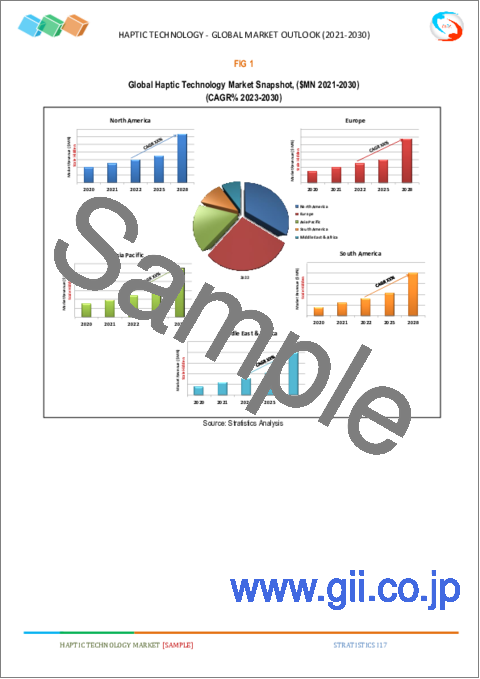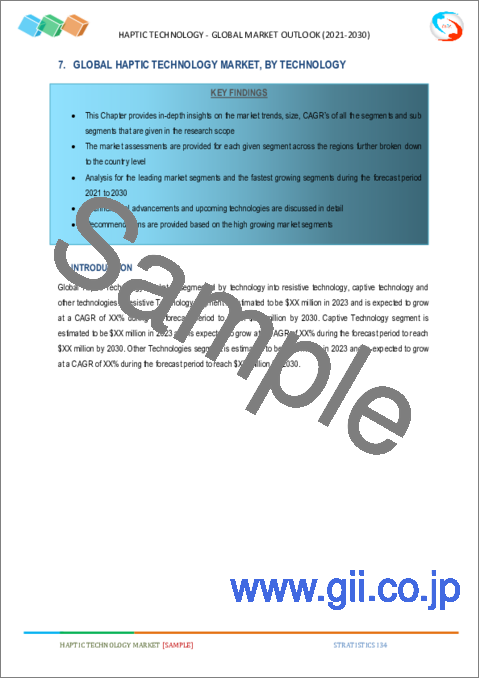|
|
市場調査レポート
商品コード
1218872
ハプティック技術の世界市場:2028年までの予測- コンポーネント、フィードバックタイプ、技術、アプリケーション、地域別の分析Haptic Technology Market Forecasts to 2028 - Global Analysis By Component, Feedback Type, Technology, Application and Geography |
||||||
|
● お客様のご希望に応じて、既存データの加工や未掲載情報(例:国別セグメント)の追加などの対応が可能です。 詳細はお問い合わせください。 |
|||||||
| ハプティック技術の世界市場:2028年までの予測- コンポーネント、フィードバックタイプ、技術、アプリケーション、地域別の分析 |
|
出版日: 2023年02月02日
発行: Stratistics Market Research Consulting
ページ情報: 英文 175+ Pages
納期: 2~3営業日
|
- 全表示
- 概要
- 図表
- 目次
Stratistics MRCによると、世界の触覚技術市場は2022年に104億米ドルを占め、2028年には218億3000万米ドルに達し、予測期間中に13.14%のCAGRで成長すると予測されています。
触覚をシミュレートする技術はハプティック技術と呼ばれ、ハプティックフィードバックはハプティクス(触覚を使って個人とコミュニケーションを取る方法)とも呼ばれます。ハプティック技術で最もよく知られているのは、携帯電話やゲーム機、ウェアラブル製品に搭載されている、振動を発生させるための小型モーターだろうが、さまざまなバリエーションがあります。例えば、マイクロ流体工学、摩擦変調、レバーや他の機械的デバイスを介してユーザーの身体や手足に力を加えることなどが挙げられます。また、ハプティック技術は、必ずしもユーザーが対象物に触れる必要はありません。非接触触覚技術により、ウェアラブル端末や制御システムは必要ありません。超音波やレーザーなどの技術を使って、空中に感覚を作り出します。
市場力学
促進要因
消費者向け機器へのハプティクス搭載の増加
ハプティック技術の需要増加を促進する重要な要素の1つは、スマートフォン、タブレット、その他のウェアラブル技術などの民生用電子機器の使用が増加していることです。スマートフォンやタブレット端末にはほぼ例外なくハプティクスが搭載されており、その動向はスマートウォッチやリストバンドへの搭載へと向かっています。よりスピーディな操作、より長いバッテリー寿命、そしてユーザーフレンドリーなインタラクションを実現するために、ハプティックフィードバックはスマートウォッチ、ブレスレット、フィットネストラッカーなどのウェアラブルデバイス技術に有用性を見いだすことができます。これらのウェアラブルデバイスのハプティクスは、情報伝達と本物の体験を可能にします。
抑制要因
フィードバック技術のコストが高い
ハプティクスは広く受け入れられるようになり、現在ではスマートフォンやタブレット端末の標準機能となっています。多くの企業がハプティクス技術の統合を検討し、そのコストとリスクを天秤にかけています。スマートフォンやタブレットにハプティクスを組み込むのにかかる費用は低いのですが、フォースフィードバック・ハプティックデバイスは、触覚フィードバック・ハプティックデバイスよりも高価です。ユーザーがさまざまな用途でリアルタイムの仮想ハプティクスを体験するためには、力触覚フィードバック・ハプティック技術には、3自由度(DoF)、6自由度(DoF)、7自由度(DoF)で利用できる効果的なデバイスが必要です。フォースフィードバックを備えた触覚デバイスは、製造業、自動車、航空宇宙、医療などの分野で、人間工学的な研究やシミュレーション用途に数多く採用されています。しかし、これらの触覚デバイスは大型であることが多く、ウェアラブル触覚デバイス技術にとって大きな課題となっています。
今後の展望
触覚技術の進歩
これまでスマートフォンやタブレット端末などの家電製品にしかなかった触覚技術が、教育やロボットなどの新しい分野でも使われるようになってきました。ロボット工学では手袋のような触覚デバイスを使うことで、ロボットオペレーターがロボットハンドなどのエンドエフェクターを細かく制御して動かします。ロボットオペレーターは、ハプティックグローブを装着することで、生産現場から何キロも離れた場所に座っていても、ロボットアームを正確に制御することができます。ロボット用触覚手袋のトップメーカーのひとつがHaptX社(米国)です。
脅威
製品設計に関わる技術的課題
ハプティック技術産業における最大の障害は、スマートフォン、タブレット、手術器具、車のダッシュボード、ゲーム機など、さまざまな製品にハプティック機能を搭載するためにメーカーが克服しなければならない技術的困難さです。触覚技術を使用するどんなガジェットでも、ユーザーの利便性とガイダンスを含めることで間違いなく利益を得られます。しかし、製品に触覚フィードバックを導入する前に、どのコンポーネントが所定のシステムで最もうまく機能するかを慎重に考えることが非常に重要です。アクチュエーターの設計と関連する駆動機能は、最高のフィードバック性能を提供するために、システムの制限下で考慮される主な要因です。生産者は、コントローラ機能を製品設計全体にどの程度含めることができるかを検討する必要があります。
COVID-19の影響
2029年、COVID-19の発生により、ハプティック技術の需要が減少しました。COVID-19パンデミックにより、官民ともに広範囲で閉鎖されました。ロックダウンと社会的隔離のガイドラインがいたるところで実施されました。ロックダウンの結果、ハプティック技術の生産とサプライチェーンは衰退しました。閉鎖はいくつかの企業の産業プロセスに大きな影響を与え、サプライチェーンの混乱を引き起こしました。自動車産業などでの労働力蓄えにより、市場に影響が出ました。COVID-19の大流行により、企業は業務に必要な労働力を確保するのに苦労しました。
予測期間中、タクタイルセグメントが最大となる見込み
触覚セグメントは、消費者がSMSアラートやその他のスマートフォン通知をカスタマイズできることから、有利な成長を遂げると推定されます。これは、触覚技術にとって有利なことです。リアルなスマートフォン体験に対する消費者の需要の増加と、消費者が自分の健康をより簡単に追跡できるスマートウォッチやリストバンドなどのモノのインターネット(IoT)対応商品の発売は、いずれも業界を後押しすることになります。
予測期間中、自動車および輸送セグメントが最も高いCAGRを示すと予想される
自動車および輸送分野は、予測期間中に最も速いCAGRの成長が見込まれています。この背景には、自動車分野の改善、電気自動車の間での高度な電子システムの需要の増加、高級車や安全車の選択、車内エンターテインメントシステムへのハプティクス技術の統合があります。アクセルペダル、ダッシュボード、空調用ディスプレイ、ステアリングホイールなどには、すべてこの技術が利用されています。主要な自動車メーカーは、BMW、ホンダ、トヨタ、ベンツ、テスラ、アウディなどのモデルにハプティクス技術を組み込んでいます。
シェアが最も高い地域
北米は、米国にImmersion Corporationのような主要な市場リーダーが存在するため、予測期間中に最大の市場シェアを占めると予測され、北米は世界のハプティック技術市場の支配的な地域になると予測されます。自動車の各ボタン、スライダー、表面、ダイヤルは、ハプティック技術によってリアルな押し心地、異なる質感、クリック感を実現することができます。そのため、自動車メーカーは徐々にハプティック技術を自動車に組み込んでいます。その結果、自動車産業におけるハプティック技術の利用が拡大し、市場の拡大に拍車がかかると予測されます。
CAGRが最も高い地域
欧州は、予測期間中に最も高いCAGRを達成すると予測されています。これは、技術的に洗練された家電製品に対する消費者の支出の増加が、欧州におけるハプティック技術市場を牽引しているためです。欧州では、特に自動車、家電、運輸の各業界で、タッチスクリーン技術に対する大きなニーズがあります。その結果、ハプティック技術の市場は欧州で大幅に拡大すると予想されます。この地域の市場拡大は、コンピューターによるトレーニング・アプリケーションにおけるこの技術の累積的な使用によって促進されると思われます。
主な発展
2021年2月、Immersion CorporationとFaurecia Corporationは、FaureciaがImmersionのハプティック技術ソリューションを購入できるよう、複数年のライセンス契約を承認しました。Faurecia社は、Immersion Corporationの最先端技術を使用して、複雑でインタラクティブなハプティック・ユーザーインターフェースを設計することができるようになる予定です。
2020年11月、Ultraleapは、UAEのHawas Groupの子会社であるIPlan Ideas Eventsおよびその部門であるIPlan Ideas Technologies(IPIテック)と契約を締結しました。この契約は、Ultraleapの先進的なハンドトラッキングと空中ハプティクス技術をUAEの顧客に提供することを目的としたものです。IPI Techは、キオスクメーカー、広告・マーケティング、小売、映画館など、幅広い業界に同技術を導入しました。
2020年9月、イマージョンはLGエレクトロニクスとライセンス更新を行い、スマートフォンにおけるタッチセンスソフトウェアとハプティック技術の継続を決定しました。
2020年6月、イマージョンは、日本の多国籍企業であるアルプス・アルパイン株式会社と契約を締結しました。この契約は、イマージョンのアクティブセンシング技術をアルプスアルパインのタッチフィードバック機器に活用することを目的としたものです。最新のアクティブセンシング技術に対応したソリューションは、高品質で忠実、かつ素早い触感を提供し、自動車のヒューマンマシンインターフェースにおけるユーザーエクスペリエンスを向上させることができます。
本レポートの内容
- 地域および国別セグメントの市場シェア評価
- 新規参入企業への戦略的提言
- 2020年、2021年、2022年、2025年、2028年の市場データを網羅
- 市場動向(市場促進要因・促進要因・機会・脅威・課題・投資機会・提言)を網羅
- 市場推定に基づく、主要ビジネスセグメントにおける戦略的推奨事項
- 主要な共通トレンドをマッピングした競合情勢
- 詳細な戦略、財務、最近の開発状況を含む企業プロファイル
- 最新の技術的進歩をマッピングしたサプライチェーン動向
無料カスタマイズサービス
本レポートをご購読のお客様には、以下のカスタマイズオプションのいずれかを無償でご提供いたします。
- 企業プロファイル
- 追加市場プレイヤーの包括的なプロファイリング(最大3社まで)
- 主要プレイヤーのSWOT分析(3社まで)
- 地域別セグメンテーション
- お客様のご希望に応じた主要国の市場推計・予測・CAGR(注:フィージビリティチェックによります。)
- 競合ベンチマーキング
- 製品ポートフォリオ、地理的プレゼンス、戦略的提携に基づく主要プレイヤーのベンチマーキング
目次
第1章 エグゼクティブサマリー
第2章 序文
- 概要
- ステークホルダー
- 調査範囲
- 調査手法
- データマイニング
- データ分析
- データ検証
- 調査アプローチ
- 調査情報源
- 1次調査情報源
- 2次調査情報源
- 仮定
第3章 市場動向分析
3.1イントロダクション
3.2促進要因
3.3抑制要因
3.4機会
3.5脅威
3.6技術分析
3.7アプリケーション分析
3.8新興市場
3.9 COVID-19の影響
第4章 ポーターズファイブフォース分析
- 供給企業の交渉力
- 買い手の交渉力
- 代替品の脅威
- 新規参入業者の脅威
- 競争企業間の敵対関係
第5章 世界の触覚技術市場:コンポーネント別
- アクチュエーターとモーター
- 偏心回転質量アクチュエータ
- 線形共振アクチュエータ
- 圧電アクチュエータ
- エレクトロアクティブポリマーアクチュエータ
- 促進要因とコントローラー
- ソフトウェア
- ハードウェア
- マイクロコントローラ
- その他のコンポーネント
第6章 世界の触覚技術市場:フィードバックタイプ別
- 力
- 触覚
第7章 世界の触覚技術市場:技術別
- 抵抗技術
- キャプティブテクノロジー
- その他の技術
第8章 世界の触覚技術市場:アプリケーション別
- ヘルスケア
- 家電
- ゲーム
- 教育
- ロボティクス
- 調査
- 政府と防衛
- モバイルコンピューティングとポータブルデバイス
- 産業、エネルギー、アウトドア
- 住宅アプリケーション
- 自動車と輸送
- その他のアプリケーション
第9章 世界の触覚技術市場:地域別
- 北米
- 米国
- カナダ
- メキシコ
- 欧州
- ドイツ
- 英国
- イタリア
- フランス
- スペイン
- その他欧州
- アジア太平洋地域
- 日本
- 中国
- インド
- オーストラリア
- ニュージーランド
- 韓国
- その他アジア太平洋地域
- 南米
- アルゼンチン
- ブラジル
- チリ
- その他南米
- 中東とアフリカ
- サウジアラビア
- アラブ首長国連邦
- カタール
- 南アフリカ
- その他中東
第10章 主な発展
- 契約、パートナーシップ、コラボレーション、合弁事業
- 買収と合併
- 新製品の発売
- 事業拡大
- その他の主要戦略
第11章 企業プロファイル
- Everlight Americas Inc.
- Citizen Electronics Co. Ltd.
- Nichia Corporation
- Immersion Corporation
- Cree Inc.
- OSRAM GmbH
- LG INNOTEK
- Toyoda Gosei Co. Ltd.
- Lumileds Holding B.V.
- Merck KGaA
- Seoul Semiconductor Co. Ltd.
- Stanley Electric Co.
- Texas Instruments Incorporated
- Ultrahaptic
- Haption S.A.
- ON Semiconductor Corporation
- Johnson Electric
- Microchip Technologies Incorporated
- Synaptics Incorporated
- SMK Corporation
List of Tables
- 1 Global Haptic Technology Market Outlook, By Region (2020-2028) ($MN)
- 2 Global Haptic Technology Market Outlook, By Component (2020-2028) ($MN)
- 3 Global Haptic Technology Market Outlook, By Actuators & Motors (2020-2028) ($MN)
- 4 Global Haptic Technology Market Outlook, By Eccentric Rotating mass actuator (2020-2028) ($MN)
- 5 Global Haptic Technology Market Outlook, By Linear Resonant Actuators (2020-2028) ($MN)
- 6 Global Haptic Technology Market Outlook, By Piezoelectric actuator (2020-2028) ($MN)
- 7 Global Haptic Technology Market Outlook, By Electro Active Polymer Actuator (2020-2028) ($MN)
- 8 Global Haptic Technology Market Outlook, By Drivers and Controllers (2020-2028) ($MN)
- 9 Global Haptic Technology Market Outlook, By Software (2020-2028) ($MN)
- 10 Global Haptic Technology Market Outlook, By Hardware (2020-2028) ($MN)
- 11 Global Haptic Technology Market Outlook, By Microcontroller (2020-2028) ($MN)
- 12 Global Haptic Technology Market Outlook, By Other Components (2020-2028) ($MN)
- 13 Global Haptic Technology Market Outlook, By Feedback Type (2020-2028) ($MN)
- 14 Global Haptic Technology Market Outlook, By Force (2020-2028) ($MN)
- 15 Global Haptic Technology Market Outlook, By Tactile (2020-2028) ($MN)
- 16 Global Haptic Technology Market Outlook, By Technology (2020-2028) ($MN)
- 17 Global Haptic Technology Market Outlook, By Resistive Technology (2020-2028) ($MN)
- 18 Global Haptic Technology Market Outlook, By Captive Technology (2020-2028) ($MN)
- 19 Global Haptic Technology Market Outlook, By Other Technologies (2020-2028) ($MN)
- 20 Global Haptic Technology Market Outlook, By Application (2020-2028) ($MN)
- 21 Global Haptic Technology Market Outlook, By Healthcare (2020-2028) ($MN)
- 22 Global Haptic Technology Market Outlook, By Consumer Electronics (2020-2028) ($MN)
- 23 Global Haptic Technology Market Outlook, By Gaming (2020-2028) ($MN)
- 24 Global Haptic Technology Market Outlook, By Education (2020-2028) ($MN)
- 25 Global Haptic Technology Market Outlook, By Robotics (2020-2028) ($MN)
- 26 Global Haptic Technology Market Outlook, By Research (2020-2028) ($MN)
- 27 Global Haptic Technology Market Outlook, By Government and Defence (2020-2028) ($MN)
- 28 Global Haptic Technology Market Outlook, By Mobile Computing and Portable Devices (2020-2028) ($MN)
- 29 Global Haptic Technology Market Outlook, By Industry, Energy and Outdoors (2020-2028) ($MN)
- 30 Global Haptic Technology Market Outlook, By Residential Applications (2020-2028) ($MN)
- 31 Global Haptic Technology Market Outlook, By Automotive & Transportation (2020-2028) ($MN)
- 32 Global Haptic Technology Market Outlook, By Other Applications (2020-2028) ($MN)
Note: Tables for North America, Europe, APAC, South America, and Middle East & Africa Regions are also represented in the same manner as above.
According to Stratistics MRC, the Global Haptic Technology Market is accounted for $10.40 billion in 2022 and is expected to reach $21.83 billion by 2028 growing at a CAGR of 13.14% during the forecast period. Technology that simulates tactile sensations is known as haptic technology, and haptic feedback is also referred to as haptics (the way touch is used to communicate with individuals). The most well-known type of haptic technology is likely the little motors used to produce vibration in mobile phones, gaming consoles, and wearables, although there are many variations. Examples include microfluidics, friction modulation, and applying force to a user's body or limbs via levers or other mechanical devices. Haptic technology does not always require users to touch an object. Wearables and control systems are not required thanks to contactless haptic technology. Using techniques like ultrasound or lasers, it creates sensory sensations in midair.
Market Dynamics:
Driver:
Increasing integration of haptics into consumer devices
One of the key elements driving the rise in demand for haptic technology is the rising use of consumer electronics devices like smartphones, tablets, and other wearable technology. Haptics are almost universally included in smartphones and tablets, and the trend is moving toward their incorporation into smartwatches and wristbands. With speedier controls, longer battery life, and user-friendly interactions, haptic feedback finds utility in wearable device technology, such as smartwatches, bracelets, and fitness trackers. These wearable's haptics enable informational communication and authentic experiences.
Restraint:
High cost for feedback technology
Haptics has become more widely accepted and is now a standardised feature in smartphones and tablets. A lot of businesses are considering the integration of haptic technology and weighing the cost and risk of doing so. Although the expenses associated with integrating haptics into smartphones and tablets are low, force feedback haptic devices are more expensive than tactile feedback haptic devices. For users to experience real-time virtual haptics in a variety of applications, force feedback haptic technology necessitates effective devices that are available in 3 degrees of freedom (DoF), 6 degrees of freedom (DoF), and 7 degrees of freedom (DoF). Haptic devices with force feedback are employed in numerous ergonomic studies as well as simulation applications in the manufacturing, automotive, aerospace, and medical fields. The fact that these haptic devices are frequently large is a significant challenge for wearable haptic device technology.
Opportunity:
Technology advancements in haptic technology
Haptic technology is now being used in new fields like education and robotics, when it was previously only found in consumer electronics like smartphones, tablets, and other mobile devices. Robot operators move a robotic hand or other end effectors with fine control by using haptic devices like gloves in robotics. Robot operators may precisely control the robot arms while sitting kilometres away from the production floor by donning haptic gloves. One of the top manufacturers of haptic gloves for robotic applications is HaptX (us).
Threat:
Technical challenges related to product design
The main obstacle in the haptic technology industry is the technological difficulty that manufacturers must overcome to include haptic capability in a variety of products, including smartphones, tablets, surgical tools, car dashboards, and gaming consoles. Any gadget that uses haptic technology will undoubtedly benefit from the inclusion of user-friendliness and guidance, but it is crucial to think carefully about which components would work best in a given system before introducing haptic feedback into a product. The actuator design and associated driving features are the main factors taken into account under system limits to provide the best feedback performance. The producers ought to look into how well the controller feature may be included into the overall product design.
COVID-19 Impact
The COVID-19 Outbreak caused a drop in demand for haptic technology in 2029. The COVID-19 Pandemic caused widespread closures of the public and private sectors. Guidelines for lockdown and social seclusion were implemented everywhere. The production and supply chain of haptic technology declined as a result of the lockdown. The shutdown had a significant impact on several businesses' industrial processes and caused supply chain disruptions. The market has been impacted by labour storages in the automotive and other industries. Due to the COVID-19 pandemic, businesses struggled to find the necessary labour for their operations.
The tactile segment is expected to be the largest during the forecast period
The tactile segment is estimated to have a lucrative growth, due to it enables consumers to customise their SMS alerts and other smartphone notifications. This is advantageous for haptic technologies. Increased consumer demand for a realistic smartphone experience and the release of Internet of Things (IoT)-enabled goods like smart watches and wristbands, which make it simpler for consumers to track their health, will both boost the industry.
The automobile and transportation segment is expected to have the highest CAGR during the forecast period
The automobile and transportation segment is anticipated to witness the fastest CAGR growth during the forecast period, due to the improvements in the automotive sector, the increased demand for advanced electronic systems among electrical vehicles, the choice for luxury and safety vehicles, and the integration of haptics technology into in-car entertainment systems are the key reasons behind this development. Accelerator pedals, dashboards, climate control displays, and steering wheels all make use of the technology. The leading automakers are integrating haptic technology into their models, including BMW, Honda, Toyota, Benz, Tesla, and Audi.
Region with highest share:
North America is projected to hold the largest market share during the forecast period owing to the existence of a major market leader like Immersion Corporation in the United States, North America is projected to become the dominant region in the global haptic technology market. Each button, slider, surface, and dial in the car can have realistic pushes, different textures, and clicks created by haptic technology. As a result, automakers are gradually integrating haptic technology into their vehicles. As a result, haptic technology's expanding use in the automotive industry is projected to spur market expansion.
Region with highest CAGR:
Europe is projected to have the highest CAGR over the forecast period; owing to Increased consumer expenditure on technologically sophisticated consumer electronics appliances is driving the market for haptic technology in Europe. Europe is demonstrating a huge need for Touchscreen technology, particularly for applications in the automotive, consumer electronics, and transportation industries. As a result, the market for haptic technology is expected to increase significantly in Europe. The region's market expansion will likely be fueled by the technology's cumulative use in computer-generated training applications.
Key players in the market
Some of the key players profiled in the Haptic Technology Market include Everlight Americas Inc., Citizen Electronics Co. Ltd., Nichia Corporation, Immersion Corporation, Cree Inc., OSRAM GmbH, LG INNOTEK, Toyoda Gosei Co. Ltd., Lumileds Holding B.V., Merck KGaA, Seoul Semiconductor Co. Ltd., Stanley Electric Co., Texas Instruments Incorporated, Ultrahaptic, Haption S.A., ON Semiconductor Corporation, Johnson Electric, Microchip Technologies Incorporated, Synaptics Incorporated and SMK Corporation.
Key Developments:
In February 2021, Immersion Corporation and Faurecia Corporation approved a multi-year licencing deal to allow Faurecia to purchase Immersion's haptic technology solutions. Faurecia will be able to design an intricate, interactive haptic user interface using cutting-edge technology from Immersion Corporation.
In November 2020, Ultraleap entered into an agreement with IPlan Ideas Events and its division, IPlan Ideas Technologies (IPI Tech), a subsidiary of UAE-based Hawas Group. The agreement aimed to bring Ultraleap's leading hand tracking and mid-air haptics technologies to customers in the UAE. IPI Tech introduced the technology to a wide range of industries, including kiosk makers, advertising and marketing, retail, and cinemas, among others.
In September 2020, Immersion signed a license renewal with LG electronics to continue the touch sense software and haptic technology in smartphones.
In June 2020, Immersion came into an agreement with Alps Alpine Co., a Japanese multinational corporation. The agreement aimed for the utilization of Immersion's Active Sensing technology into the Alps Alpine's touch feedback devices. The latest Active Sensing technology-enabled solutions offer a high-quality, high-fidelity, and quick-to-respond tactile impact for enhanced user experiences in automotive human-machine interfaces.
Components Covered:
- Actuators & Motors
- Drivers and Controllers
- Software
- Hardware
- Microcontroller
- Other Components
Feedback Types Covered:
- Force
- Tactile
Technologies Covered:
- Resistive Technology
- Captive Technology
- Other Technologies
Applications Covered:
- Healthcare
- Consumer Electronics
- Gaming
- Education
- Robotics
- Research
- Government and Defence
- Mobile Computing and Portable Devices
- Industry, Energy and Outdoors
- Residential Applications
- Automotive & Transportation
- Other Applications
Regions Covered:
- North America
- US
- Canada
- Mexico
- Europe
- Germany
- UK
- Italy
- France
- Spain
- Rest of Europe
- Asia Pacific
- Japan
- China
- India
- Australia
- New Zealand
- South Korea
- Rest of Asia Pacific
- South America
- Argentina
- Brazil
- Chile
- Rest of South America
- Middle East & Africa
- Saudi Arabia
- UAE
- Qatar
- South Africa
- Rest of Middle East & Africa
What our report offers:
- Market share assessments for the regional and country-level segments
- Strategic recommendations for the new entrants
- Covers Market data for the years 2020, 2021, 2022, 2025, and 2028
- Market Trends (Drivers, Constraints, Opportunities, Threats, Challenges, Investment Opportunities, and recommendations)
- Strategic recommendations in key business segments based on the market estimations
- Competitive landscaping mapping the key common trends
- Company profiling with detailed strategies, financials, and recent developments
- Supply chain trends mapping the latest technological advancements
Free Customization Offerings:
All the customers of this report will be entitled to receive one of the following free customization options:
- Company Profiling
- Comprehensive profiling of additional market players (up to 3)
- SWOT Analysis of key players (up to 3)
- Regional Segmentation
- Market estimations, Forecasts and CAGR of any prominent country as per the client's interest (Note: Depends on feasibility check)
- Competitive Benchmarking
- Benchmarking of key players based on product portfolio, geographical presence, and strategic alliances
Table of Contents
1 Executive Summary
2 Preface
- 2.1 Abstract
- 2.2 Stake Holders
- 2.3 Research Scope
- 2.4 Research Methodology
- 2.4.1 Data Mining
- 2.4.2 Data Analysis
- 2.4.3 Data Validation
- 2.4.4 Research Approach
- 2.5 Research Sources
- 2.5.1 Primary Research Sources
- 2.5.2 Secondary Research Sources
- 2.5.3 Assumptions
3 Market Trend Analysis
3.1 Introduction
3.2 Drivers
3.3 Restraints
3.4 Opportunities
3.5 Threats
3.6 Technology Analysis
3.7 Application Analysis
3.8 Emerging Markets
3.9 Impact of Covid-19
4 Porters Five Force Analysis
- 4.1 Bargaining power of suppliers
- 4.2 Bargaining power of buyers
- 4.3 Threat of substitutes
- 4.4 Threat of new entrants
- 4.5 Competitive rivalry
5 Global Haptic Technology Market, By Component
- 5.1 Introduction
- 5.2 Actuators & Motors
- 5.2.1 Eccentric Rotating mass actuator
- 5.2.2 Linear Resonant Actuators
- 5.2.3 Piezoelectric actuator
- 5.2.4 Electro Active Polymer Actuator
- 5.3 Drivers and Controllers
- 5.4 Software
- 5.5 Hardware
- 5.6 Microcontroller
- 5.7 Other Components
6 Global Haptic Technology Market, By Feedback Type
- 6.1 Introduction
- 6.2 Force
- 6.3 Tactile
7 Global Haptic Technology Market, By Technology
- 7.1 Introduction
- 7.2 Resistive Technology
- 7.3 Captive Technology
- 7.4 Other Technologies
8 Global Haptic Technology Market, By Application
- 8.1 Introduction
- 8.2 Healthcare
- 8.3 Consumer Electronics
- 8.4 Gaming
- 8.5 Education
- 8.6 Robotics
- 8.7 Research
- 8.8 Government and Defence
- 8.9 Mobile Computing and Portable Devices
- 8.10 Industry, Energy and Outdoors
- 8.11 Residential Applications
- 8.12 Automotive & Transportation
- 8.13 Other Applications
9 Global Haptic Technology Market, By Geography
- 9.1 Introduction
- 9.2 North America
- 9.2.1 US
- 9.2.2 Canada
- 9.2.3 Mexico
- 9.3 Europe
- 9.3.1 Germany
- 9.3.2 UK
- 9.3.3 Italy
- 9.3.4 France
- 9.3.5 Spain
- 9.3.6 Rest of Europe
- 9.4 Asia Pacific
- 9.4.1 Japan
- 9.4.2 China
- 9.4.3 India
- 9.4.4 Australia
- 9.4.5 New Zealand
- 9.4.6 South Korea
- 9.4.7 Rest of Asia Pacific
- 9.5 South America
- 9.5.1 Argentina
- 9.5.2 Brazil
- 9.5.3 Chile
- 9.5.4 Rest of South America
- 9.6 Middle East & Africa
- 9.6.1 Saudi Arabia
- 9.6.2 UAE
- 9.6.3 Qatar
- 9.6.4 South Africa
- 9.6.5 Rest of Middle East & Africa
10 Key Developments
- 10.1 Agreements, Partnerships, Collaborations and Joint Ventures
- 10.2 Acquisitions & Mergers
- 10.3 New Product Launch
- 10.4 Expansions
- 10.5 Other Key Strategies
11 Company Profiling
- 11.1 Everlight Americas Inc.
- 11.2 Citizen Electronics Co. Ltd.
- 11.3 Nichia Corporation
- 11.4 Immersion Corporation
- 11.5 Cree Inc.
- 11.6 OSRAM GmbH
- 11.7 LG INNOTEK
- 11.8 Toyoda Gosei Co. Ltd.
- 11.9 Lumileds Holding B.V.
- 11.10 Merck KGaA
- 11.11 Seoul Semiconductor Co. Ltd.
- 11.12 Stanley Electric Co.
- 11.13 Texas Instruments Incorporated
- 11.14 Ultrahaptic
- 11.15 Haption S.A.
- 11.16 ON Semiconductor Corporation
- 11.17 Johnson Electric
- 11.18 Microchip Technologies Incorporated
- 11.19 Synaptics Incorporated
- 11.20 SMK Corporation




